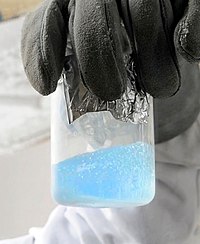
Photo from wikipedia
Smoking is a significant risk factor in fatal pathologies including cardio-cerebrovascular and respiratory diseases. Aluminum (Al) is a toxic element without known biological function, but with recognized toxic effects. Manganese… Click to show full abstract
Smoking is a significant risk factor in fatal pathologies including cardio-cerebrovascular and respiratory diseases. Aluminum (Al) is a toxic element without known biological function, but with recognized toxic effects. Manganese (Mn) and selenium (Se) are essential trace elements involved in cellular antioxidant defense mechanisms. Al, Mn, and Se carry out their metabolic activities via blood flow and tissue oxygenation. The structure and number of red blood cells (RBC) play important role in tissue oxygenation throughout blood flow. Increased hematocrit (Hct) as a result of probable hypoxia induces disturbed blood flow, RBC aggregation (RBC Agg), RBC deformability index (Tk), and oxygen delivery index (ODI). Therefore, we aimed to investigate the effects of altered Al, Mn, and Se levels on number, structure, and function of RBCs (Hct, blood and plasma viscosity (BV and PV, respectively), RBC Agg, Tk, ODI) in smokers without diagnosis of chronic obstructive pulmonary disease (COPD) in a study group (n = 128) categorized as ex-smokers (ES), smokers (S), and healthy controls (HC). Elements were analyzed in serum using ICP-OES. BV and PV were measured via Brookfield and Harkness viscometers at 37 °C, respectively. Smokers had statistically higher serum Al and Mn levels, BV, RBC, Hgb, Hct, PV, fibrinogen, RBC Agg, Tk45, and pulmonary blood flow rate, but lower serum Se levels and ODI45 values versus HC. In conclusion, increased Al, Mn, and hemorheological parameters and decreased Se and ODI45 might result from inflammatory response in defense mechanism in smokers without diagnosis of COPD. Our results point out that serum Al, Mn, and Se with hemorheological parameters may be beneficial markers of tissue oxygenation and defense mechanism before the clinic onset of COPD in smokers.
Journal Title: Biological Trace Element Research
Year Published: 2018
Link to full text (if available)
Share on Social Media: Sign Up to like & get
recommendations!